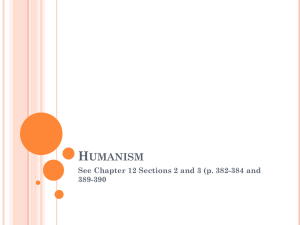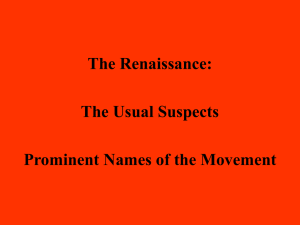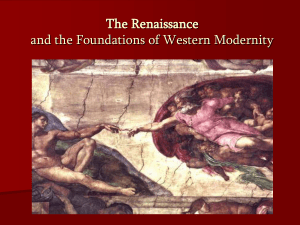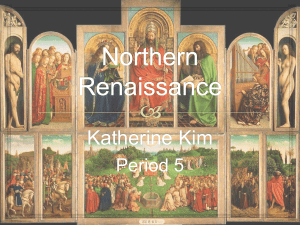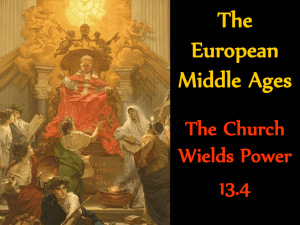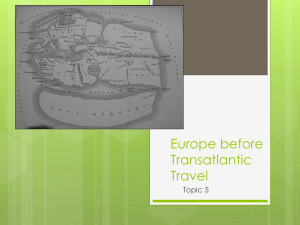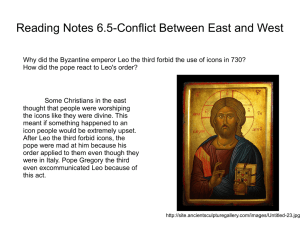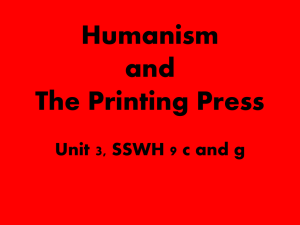Chapter 12: The Renaissance
advertisement
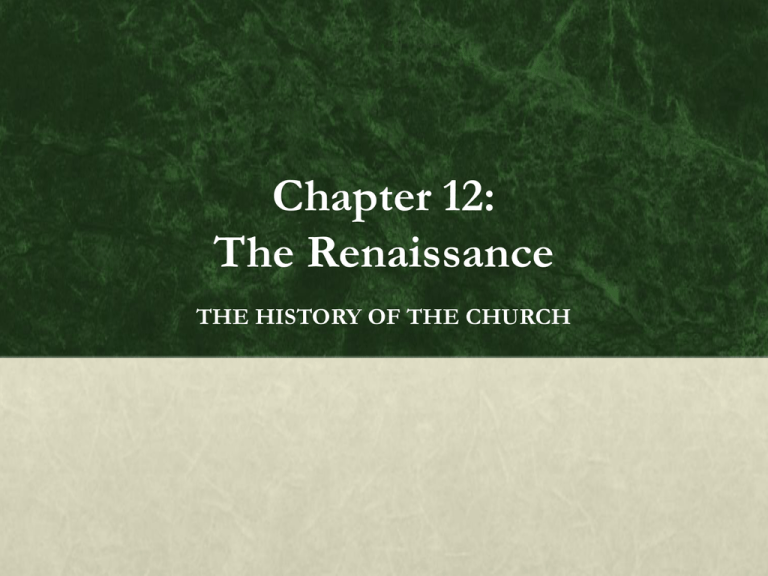
Chapter 12: The Renaissance THE HISTORY OF THE CHURCH 1. The Fall of Constantinople and the Rise of the Italian Free Cities (pp. 424–429) ANTICIPATORY SET View an official copy of the bull Lætentur Cœli on the Vatican Web site, and read a brief history of this document that proclaimed the agreement reached between the Eastern and Western Churches at the Ecumenical Council of Basel-Ferrara-Florence: asv.vatican.va/en/doc/1439.htm 1. The Fall of Constantinople and the Rise of the Italian Free Cities (pp. 424–429) BASIC QUESTIONS Why did the Pope convene the Ecumenical Council of Basel-Ferrara-Florence, and what was its effect? What were the effects of the fall of Constantinople? KEY IDEAS Pope Eugene IV and the Roman (Byzantine) emperor John VIII orchestrated the Ecumenical Council of Basel-Ferrara-Florence to effect a reunification of East and West. John VIII hoped that reunion would result in military aid for his besieged empire. The Greek populace rejected the Ecumenical Council, no significant military aid reached Constantinople, and the city fell to the Turks in 1453, ending a thousandyear Christian empire and embittering the Greeks toward the West. The Italian city-states benefitted culturally and financially from the shift of trade from Greece to Italy. 1. The Fall of Constantinople and the Rise of the Italian Free Cities (pp. 424–429) GUIDED EXERCISE Complete a Think/Pair/Share using the following question: Why was the Ecumenical Council of Basel-Ferrara-Florence a disappointment for Emperor John VIII? 1. The Fall of Constantinople and the Rise of the Italian Free Cities (pp. 424–429) FOCUS QUESTION What kind of intellectual change did the Renaissance embody? The Renaissance was a turning away from the Scholasticism of the Middle Ages and its Theocentric view of life toward classic literary texts, GrecoRoman civilization, a reawakening of a sense of human greatness, and an anthropocentric view of life. 1. The Fall of Constantinople and the Rise of the Italian Free Cities (pp. 424–429) FOCUS QUESTIONS What does the word renaissance mean? This French word means “rebirth.” According to Pope Bl. John Paul II, how does the Church see the pursuit of human power and wisdom? Human wisdom and solutions to human needs are limited but important; they can be united to and redeemed by Christ. 1. The Fall of Constantinople and the Rise of the Italian Free Cities (pp. 424–429) FOCUS QUESTIONS How did the Italian cities differ from those throughout most of Europe? While most of Europe was engaged in internal wars, Florence, Venice, Genoa, and other Italian cities were marked by commerce. What were the effects of the decline of the Roman (Byzantine) Empire with respect to the Italian city-states? First, the center of trade shifted from Constantinople to the Italian cities. Second, Greek intellectuals fleeing the instability of their empire settled there. 1. The Fall of Constantinople and the Rise of the Italian Free Cities (pp. 424–429) FOCUS QUESTIONS How did the Turks weaken the Roman (Byzantine) Empire? The Ottoman Turks had conquered the Balkans and advanced all the way to Hungary by the end of the fourteenth century. What threat did the Roman (Byzantine) Empire survive at the end of the fourteenth century? The Ottoman Turks laid siege to Constantinople but had to withdraw due to Mongol attacks from the east. 1. The Fall of Constantinople and the Rise of the Italian Free Cities (pp. 424–429) FOCUS QUESTION How did the threat posed by the Ottoman Empire affect East-West Church relations? The common danger the Church in the East and West faced from Islam drew the hierarchs of the two sides together. The Venetians were interested especially in good financial relations with the East. Pope Eugene IV, a Venetian, wanted to reunite East and West to launch a unified crusade against the Turks. 1. The Fall of Constantinople and the Rise of the Italian Free Cities (pp. 424–429) GUIDED EXERCISE Search the Internet for the article “The Fall of Constantinople, 1453” by Dionysios Hatzopoulos, and read silently this poignant account of the siege and fall of Constantinople based on eyewitness accounts. 1. The Fall of Constantinople and the Rise of the Italian Free Cities (pp. 424–429) FOCUS QUESTIONS What did Pope Eugene IV want out of the Ecumenical Council of Basel-Ferrara-Florence? He hoped to end the Great Schism. What did Emperor John VIII want out of the Ecumenical Council of Basel-Ferrara-Florence? He wanted to establish quickly a military alliance between East and West and avoid lengthy theological discussions. 1. The Fall of Constantinople and the Rise of the Italian Free Cities (pp. 424–429) FOCUS QUESTIONS How did Pope Eugene IV promote dialogue between the Greek and Latin Council Fathers? He formed commissions made up of Greeks and Latins to draft a clear conclusion to each issue. What was the result of the Ecumenical Council of Basel-FerraraFlorence? In 1439 the council Fathers agreed to reunite the two Churches. Under pressure from Emperor John VIII, the Greek bishops accepted the addition of Filioque to the Creed, the existence of Purgatory, and the 1. The Fall of Constantinople and the Rise of the Italian Free Cities (pp. 424–429) GRAPHIC ORGANIZER Work with a partner to complete the following table on the Ecumenical Council of Basel-Ferrara-Florence. 1. The Fall of Constantinople and the Rise of the Italian Free Cities (pp. 424–429) 1. The Fall of Constantinople and the Rise of the Italian Free Cities (pp. 424–429) FOCUS QUESTIONS What did it mean for eastern Christians to have said, “Better the turban than the tiara”? In Constantinople most people felt it better to be conquered by Turks than be under the Pope’s influence. Why did the Ecumenical Council of Basel-Ferrara-Florence not reunite East and West? Popular Greek sentiment against the West was very strong. Some Greek hierarchs campaigned against the agreement upon returning home. The actual proclamation of reunion was not performed in the East until 1452 and was rejected by the people of Constantinople. The next year Constantinople fell to Turkish Muslim forces, and the Roman (Byzantine) Empire was no more. 1. The Fall of Constantinople and the Rise of the Italian Free Cities (pp. 424–429) FOCUS QUESTION What was the outcome of the fall of Constantinople? The Greeks were subject to foreign rule for the first time in 1000 years. The city was pillaged for three days and nights. Hagia Sophia was stripped and turned into a mosque. Greeks felt great animosity toward the Latin Church, blaming her for first weakening Constantinople during the Fourth Crusade and then not coming to its aid. 1. The Fall of Constantinople and the Rise of the Italian Free Cities (pp. 424–429) FOCUS QUESTIONS What is studia humanitatis? This humanistic curriculum emphasized classical literature and languages. How long did Muslim rule in Constantinople continue? Except for a brief period after World War I, it continues to the present day. 1. The Fall of Constantinople and the Rise of the Italian Free Cities (pp. 424–429) FOCUS QUESTIONS What was the political character of the Italian city-states? The Italian city-states were not nationalistic but small, independent republics. Besides wielding temporal power in Italy, what did the Renaissance Popes do? They financed art and architecture and encouraged the founding of schools and universities. 1. The Fall of Constantinople and the Rise of the Italian Free Cities (pp. 424–429) FOCUS QUESTIONS How did Italy benefit from the fall of Constantinople? Trade shifted from Constantinople to Venice, Genoa, and Florence. These became cosmopolitan centers in which Christians, Jews, and Muslims bought and sold merchandise side by side. How was the urbanization of peasants in Italy different than in France? In France peasants fled to cities to escape famine and war. In Italy, where the feudal structure had been much weaker, they moved to cities to trade and sell goods. 1. The Fall of Constantinople and the Rise of the Italian Free Cities (pp. 424–429) HOMEWORK ASSIGNMENT Study Questions 1–8 (p. 460) Workbook Questions 1–25 Read “The Birth of Humanism and the Flourishing of Arts and Letters” through “Nicolo Machiavelli” (pp. 429–436) 1. The Fall of Constantinople and the Rise of the Italian Free Cities (pp. 424–429) CLOSURE Write a paragraph about why the Ecumenical Council of Basel-FerraraFlorence was convened and what it accomplished. 1. The Fall of Constantinople and the Rise of the Italian Free Cities (pp. 424–429) ALTERNATIVE ASSESSMENT Imagine you are a Greek Orthodox citizen of Constantinople who escaped the city during its fall. Write a letter revealing your feelings about the recent council and the Western Church in general. 2. The Birth of Humanism and the Good Letters (pp. 429–436) ANTICIPATORY SET Discuss the following questions: Why was it reasonable for Medieval universities to have seen theology as the highest area of learning, focusing more on the next world than this one? How might you expect university education to have changed when the student population no longer consisted primarily of monks and clerics? 2. The Birth of Humanism and the Good Letters (pp. 429–436) BASIC QUESTIONS What intellectual shift gave birth to humanism? What are the core values of humanism? Who were some of the early major humanist writers? KEY IDEAS In Italian universities there was a shift from Scholastic theology to the study of rhetoric, grammar, and history with enthusiasm for Greco-Roman literature, art, and architecture. Humanism was an intellectual and literary movement; its education was based on classical literary texts intended to make the student better, wiser, and more virtuous. Christian humanism joined an appreciation for classical culture with the view that man is made in the image of God and has God as his ultimate end. Dante’s Divine Comedy strikes a balance between a person’s earthly condition and life after death. Petrarch was a master of Latin and vernacular love poetry. Boccaccio was a comic poet who exposed the foibles and weaknesses in human nature. Machiavelli’s The Prince portrays an amoral use of means to secure political power. 2. The Birth of Humanism and the Good Letters (pp. 429–436) FOCUS QUESTIONS What intellectual shift took place in universities? There was a shift away from Scholastic theology to rhetoric, grammar, and history with great enthusiasm for Greco-Roman literature, art, and architecture. Why did the humanists consider art the pinnacle of human achievement? In art, the human person could craft beautiful forms—perfect in form, balance, and composition. 2. The Birth of Humanism and the Good Letters (pp. 429–436) FOCUS QUESTION What does it mean to say that Medieval education was specialized, and what problem did the humanists see with this specialization? At the doctoral level, a person would study medicine to become a doctor; logic, philosophy, and theology to become a theologian; and law to be a lawyer. The humanists thought that Medieval education lacked the moral purpose of making people wiser and more virtuous. 2. The Birth of Humanism and the Good Letters (pp. 429–436) GUIDED EXERCISE Discuss this humanistic belief and the following question: A classical training alone, based on the literature and culture of classical antiquity, could form a perfect human person. Do you think this belief is true? 2. The Birth of Humanism and the Good Letters (pp. 429–436) FOCUS QUESTIONS What are bonæ litteræ and litteræ humaniores? The terms “good letters” and “more humane letters” refer to the ancient Greek and Roman authors, who focused more on the human person’s relation to the world than on his or her relation to God. To what extent is humanism a revival of paganism? Some humanists displayed an inordinate reverence for pagan thinkers and writers and held a worldly outlook devoid of religion. What is Christian humanism? This form of humanism integrates the humanistic perspective with the Revelation of the human person as made in the image and likeness of God. 2. The Birth of Humanism and the Good Letters (pp. 429–436) GUIDED EXERCISE Read silently the quote from Pope Bl. John Paul II (p. 430), and then free write for two minutes about how this is a statement of Christian humanism. 2. The Birth of Humanism and the Good Letters (pp. 429–436) FOCUS QUESTION Why is Dante Alighieri considered both a Medieval and Renaissance writer? Dante lived at the end of the Middle Ages and was concerned with not only man’s earthly condition but also his eternal destiny. Dante had a great admiration for classical authors; though they could not go to Heaven, Dante did not condemn them to Hell but left them in limbo in his Divine Comedy. 2. The Birth of Humanism and the Good Letters (pp. 429–436) FOCUS QUESTIONS Where did the term “poet laureate” originate? A Roman Senator crowned Petrarch poet laureate from the custom of crowning heroes with laurel leaves. To whom and in what language did Petrarch write his sonnets? Petrarch wrote his sonnets in his vernacular Italian to Laura, a married woman with whom he was madly in love. 2. The Birth of Humanism and the Good Letters (pp. 429–436) GUIDED EXERCISE Work with a partner to identify Petrarch’s lifelong struggle and discuss the following question: Is there really a contradiction between passionately loving the world and hoping for eternal life? 2. The Birth of Humanism and the Good Letters (pp. 429–436) FOCUS QUESTIONS What is Petrarch’s Secretum? This is an imagined series of personal, meditative, imaginary dialogues between himself and St. Augustine under the watchful eye of Lady Truth. Why did many think that Petrarch was envious of Dante? Petrarch never mentioned Dante by name, though Dante was his immediate predecessor. According to his letter to Boccaccio, what was Petrarch’s problem with Dante? Petrarch thought that he understood Dante better than the many who praised him. He claimed that reading Dante early in his career might have kept him from developing his own, unique style. 2. The Birth of Humanism and the Good Letters (pp. 429–436) FOCUS QUESTIONS In what language did Boccaccio write Decameron? He wrote it in Italian, never having mastered Latin. What is the structure of Decameron? It is comprised of 100 novellas in which ten people each tell one story each day for ten days while they stay in a villa outside Naples to escape plague-ridden Florence. On what theme did Boccaccio focus? He focused on the foibles and weaknesses of people. He had more contempt for stupidity and ignorance than for vice. 2. The Birth of Humanism and the Good Letters (pp. 429–436) GUIDED EXERCISE Search the Internet for Boccaccio’s Decameron and many others of Boccaccio’s writings. Take a few minutes to scan them to gain an appreciation for their style. 2. The Birth of Humanism and the Good Letters (pp. 429–436) FOCUS QUESTIONS Which author and book are synonymous with ruthless political conduct? Nicolo Machiavelli wrote The Prince. Why did Machiavelli think a prince must model himself on both the fox and the lion? The fox can protect himself against traps, and the lion can frighten wolves. 2. The Birth of Humanism and the Good Letters (pp. 429–436) FOCUS QUESTION What is Machiavellianism? It is the principle that the ends justify the means, that is, a politician can use any method to get ahead. This is opposed to the works of Plato and Aristotle, whom Machiavelli dismisses as “those who have spoken in the past regarding how a lord should rule.” 2. The Birth of Humanism and the Good Letters (pp. 429–436) HOMEWORK ASSIGNMENT Study Questions 9–16 (p. 460) Practical Exercise 2 (p. 461) Workbook Questions 26–47 Read “Humanism in Painting and Sculpture” through “Rabelais” (pp. 437–445) 2. The Birth of Humanism and the Good Letters (pp. 429–436) CLOSURE Write a paragraph explaining the origin and core views of humanism. 2. The Birth of Humanism and the Good Letters (pp. 429–436) ALTERNATIVE ASSESSMENT Take five minutes to write a dialogue between an enthusiastic young Renaissance humanist scholar and a second-century Christian about to be martyred in the arena. 3. The Flourishing of Arts (pp. 437–445) ANTICIPATORY SET To provide a quick survey of the visual arts during the Italian Renaissance, complete the Guided Exercise on page 439. 3. The Flourishing of Arts (pp. 437–445) BASIC QUESTIONS What was the importance of Michelangelo to the arts during the Renaissance? What were the contributions of St. Thomas More and Erasmus to Northern humanism? KEY IDEAS Among many artists skilled at depicting the human form, Michelangelo was perhaps the greatest painter and sculptor of the Renaissance. St. Thomas More and Erasmus were the outstanding intellectual figures of Northern Renaissance humanism. 3. The Flourishing of Arts (pp. 437–445) FOCUS QUESTIONS How were the great works of the Renaissance financed? They were commissioned by wealthy families, kings, and Popes. What is a Renaissance Man, and how is Michelangelo one? A Renaissance man excels in many disciplines. Michelangelo was a great sculptor, painter, and architect. 3. The Flourishing of Arts (pp. 437–445) FOCUS QUESTION For what depictions of the human form is Michelangelo best known, and why have these works endured? He depicted the contours of the human body such that the grandeur of man comes out with overwhelming force. Two examples are his sculpture David and the people depicted on the ceiling of the Sistine Chapel. 3. The Flourishing of Arts (pp. 437–445) GUIDED EXERCISE Work with a partner to research an assigned Renaissance artist or work of art. Do five minutes of research online, writing two sentences on a separate sheet of paper describing the artist or work of art. 3. The Flourishing of Arts (pp. 437–445) GUIDED EXERCISE Raphael was an artist who is best known for his portraits of the Madonna (“My Lady,” the Blessed Virgin Mary) and large paintings in the Vatican apartments. Search the Internet for and read some commentary and view many examples of his work to gain a better appreciation of Raphael. 3. The Flourishing of Arts (pp. 437–445) FOCUS QUESTION How were the circumstances surrounding humanism in northern Europe different from those in Italy? The North did not see significant changes in its economy, social life, and education. There was not a rise in prosperity or a significant middle class; most of the people were rural and poor. In the North, the new anthropocentric mindset was integrated into the Christian outlook, the result of which was Christian humanism. 3. The Flourishing of Arts (pp. 437–445) FOCUS QUESTIONS How does the Catholic Church view St. Thomas More? The Fathers of the Second Vatican Council held up St. Thomas as an example for all people of the “inalienable dignity of the human conscience” (Gaudium et Spes 16). Pope Bl. John Paul II put forth St. Thomas as an imperishable witness to moral integrity: “the primacy of truth over power.” What were St. Thomas’s qualifications as a humanist? He mastered Greek and Latin and received a liberal education. 3. The Flourishing of Arts (pp. 437–445) FOCUS QUESTIONS By what title is Erasmus known? He is called the Father of Northern Humanism. How did Erasmus view the Middle Ages compared to the classical era? He saw the Middle Ages and Scholasticism as unenlightened and stagnant while holding the classical thinkers in highest esteem. What was Erasmus’s attitude toward human virtues? He extolled human virtues, especially prudence, intellectual honesty, zeal for truth, and consideration for others. These led him to desire reform 3. The Flourishing of Arts (pp. 437–445) HOMEWORK ASSIGNMENT Study Questions 17–20 (p. 460) Practical Exercise 1 (p. 461) Workbook Questions 48–67 Read “Popes and Politics” through “Innocent VIII, Alexander VI, and Julius II” (pp. 445–451) 3. The Flourishing of Arts (pp. 437–445) CLOSURE Free write for five minutes about whom you consider the three most important figures in this lesson. 3. The Flourishing of Arts (pp. 437–445) ALTERNATIVE ASSESSMENT Work with a partner to answer one of the following questions, using the material on St. Thomas a Becket, Machiavelli, and King Henry VIII (pp. 479–483): 1. How are St. Thomas More and Machiavelli on opposite ends of the political spectrum? 2. How do Sts. Thomas More and Thomas a Becket compare? 4. Popes and Politics (pp. 445–451) ANTICIPATORY SET Search the Internet for and take a virtual tour of Renaissance Florence. 4. Popes and Politics (pp. 445–451) BASIC QUESTIONS What was the importance of the Medici family in Florence? Who were the major Renaissance Popes, and what were their contributions? KEY IDEAS The Medicis were the major bankers of Italy and used their power and wealth to maintain political power in Florence for a century; influence Popes and European politics; and undertake major patronage of the arts, for which they are best remembered today. While some Renaissance Popes lived moral lives, contributed to scholarship and learning, sought reconciliation with the East, and tried to unify Christendom against the Turkish threat, others were worldly rulers who sought political power and to build up Rome as a great city filled with beautiful art and architecture. 4. Popes and Politics (pp. 445–451) FOCUS QUESTIONS Which family dominated the history of Florence during the Renaissance? The Medici family dominated. For what are the Medici best known today? Besides their political power and wealth, they are best known for their extraordinary generosity and patronage of the arts. How was the religious practice of the Medici family? They fluctuated between worldly decadence and fervent practice of the Faith. 4. Popes and Politics (pp. 445–451) FOCUS QUESTION What were the two major tasks of Renaissance merchant bankers? They bought, sold, and traded bills of exchange and lent money for investments. Banking families were important sources of wealth for kings who desired funds for war. The Fuggers were the backbone of the Hapsburgs, the Medicis of the French kings. 4. Popes and Politics (pp. 445–451) FOCUS QUESTIONS Which was the chief merchant banking family during the Renaissance? The Medicis were chief. What was the source of wealth of the most successful German banking family? The Fuggers’ source of wealth was mining and trading silver, copper, and mercury. 4. Popes and Politics (pp. 445–451) GUIDED EXERCISE Complete a Think/Pair/Share using the following question: What were the effects of the Medici family’s wealth? 4. Popes and Politics (pp. 445–451) FOCUS QUESTIONS Who was Savonarola? He was a puritanical Dominican friar who drove the Medici from Florence for three years and tried to reform public morals and restore the republic. He was burned as a heretic. How did the Renaissance Popes generally live? They lived generally like worldly princes. 4. Popes and Politics (pp. 445–451) FOCUS QUESTION How did Tommaso Parentucelli’s scholarship help communicate effectively with Eastern Christians? Parentucelli’s familiarity with Scholastic philosophy and the Church Fathers gave him prominence among the Greek bishops who attended the Ecumenical Council of Basel-Ferrara-Florence. 4. Popes and Politics (pp. 445–451) GUIDED EXERCISE Work with a partner to identify the major tasks that Pope Nicholas V undertook and discuss the following question: What better tasks might Pope Nicholas V have undertaken? 4. Popes and Politics (pp. 445–451) FOCUS QUESTIONS How was Pope Nicholas V a promoter of literature? He saved thousands of ancient texts; founded the Vatican library, which housed more than 5000 works; and sponsored humanist writers and translators of Greek classics. What were Pope Nicholas’s doctrinal contributions? He finalized the condemnation of the Conciliarist heresy, won the submission of Antipope Felix V, and sent great theologians to northern Europe to stem growing religious dissent among the clergy and laity. 4. Popes and Politics (pp. 445–451) FOCUS QUESTIONS What was the result of Pope Nicholas’s political failures? Pope Nicholas’s inability to achieve greater political unity in Europe made it impossible to defend Constantinople against the Turkish threat, leading to that city’s fall in 1453. How was Pope Callistus III preoccupied during his pontificate? He tried to get the princes of Europe to recognize the Turkish threat and unite to defend Christendom. 4. Popes and Politics (pp. 445–451) FOCUS QUESTIONS How could Pius II’s early life be said to be an unlikely one for a future Pope? His early life was marked by moral laxity, a fervent embrace of pagan culture, and support for Conciliarism against papal authority. What was the focus of Pius II’s pontificate? Like Callistus III, Pius II focused on overcoming the Turkish threat but was likewise unsuccessful. 4. Popes and Politics (pp. 445–451) GUIDED EXERCISE Work with a partner to identify the failures and successes of Pope Sixtus IV. 4. Popes and Politics (pp. 445–451) HOMEWORK ASSIGNMENT Study Questions 21–23 (p. 460) Practical Exercise 3 (p. 461) Workbook Questions 68–89 Read “The Rise of New Monarchs” through “Conclusion” (pp. 451–457) 4. Popes and Politics (pp. 445–451) CLOSURE Free write for five minutes about either of the Basic Questions of this lesson: What was the importance of the Medici family in Florence? Who were the major Renaissance Popes, and what were their contributions? 4. Popes and Politics (pp. 445–451) ALTERNATIVE ASSESSMENT Discuss three Renaissance Popes—Innocent VIII, Alexander VI, and Julius II—using the following questions: What were some of the successes and failures of these Popes? How can the moral failures of some Popes actually demonstrate papal infallibility? 5. The Rise of New Monarchs (pp. 451–457) ANTICIPATORY SET Work with a partner to perform a paragraph shrink on the paragraph “In the fifteenth century…” (p. 451). 5. The Rise of New Monarchs (pp. 451–457) BASIC QUESTION What was the new kind of monarch that arose during the fifteenth century? KEY IDEA A new kind of monarch arose in France, England, Spain, and Germany; these kings and queens centralized power by controlling the military, strengthened the revenue bases of the crown, and imposed uniform law, including some degree of control over the Church. 5. The Rise of New Monarchs (pp. 451–457) FOCUS QUESTIONS How did King Louis XI consolidate power in France? He gained military control of the entire nation, instituted a perpetual tax independent of the Estates General, and promoted a form of Conciliarism to control the Church. How did King Henry VII consolidate power in England? The Tudors won the War of the Roses. King Henry VII avoided further wars, granted monopolies, weakened the powers of local nobles, and allied himself with Spain through a marriage between his son and the daughter of Queen Isabella. 5. The Rise of New Monarchs (pp. 451–457) FOCUS QUESTIONS How did Queen Isabella unify Spain, and what was its effect? Queen Isabella consolidated Spain politically through the Reconquista and culturally by the imposition of Catholicism as the only religion. This made Spain the most powerful country in Europe for the next 150 years. What positive change in the rules of war did Queen Isabella impose during the Reconquista? She punished by hanging any soldier who raped or plundered. 5. The Rise of New Monarchs (pp. 451–457) FOCUS QUESTIONS What did Queen Isabella do to Jews and Muslims in order to carry out the principle of unity of Faith? She expelled any who would not convert to Catholicism. What problem did the principle of unity of faith create? By putting unjust pressure on its non-Christian inhabitants, the state created the problem of secret Jews and Muslims—or at least the suspicion of such people. In addition, because many of the middle class tradesmen were Jews and Muslims, their expulsion hurt manufacturing and contributed to the economic decline of Spain. 5. The Rise of New Monarchs (pp. 451–457) GUIDED EXERCISE Discuss the positive and negative elements of unity of faith within a society. 5. The Rise of New Monarchs (pp. 451–457) FOCUS QUESTIONS What made Cardinal Ximenes de Cisneros famous throughout Spain? He had a great reputation as a confessor (spiritual director). How did Cardinal Ximenes lead a Catholic reformation in Spain? He built the University of Alcala and introduced humanism in Spain, reformed clerical orders, and curbed abuses of the Inquisition. How did Cardinal Ximenes defend human rights? As regent of Spain after the death of Isabella, he insisted on honoring her commands to protect the rights of African slaves and Native Americans. 5. The Rise of New Monarchs (pp. 451–457) FOCUS QUESTIONS Why was the power of the Holy Roman emperors limited? The authority of the emperor was limited severely by centuries of feudal agreements. How long did the Hapsburg dynasty rule the Holy Roman Empire? They ruled about 350 years (1452–1806). 5. The Rise of New Monarchs (pp. 451–457) FOCUS QUESTION What were Emperor Charles V’s inheritances, which made him the most powerful ruler in Europe? He inherited significant lands from each of his four grandparents: Austria from Maximilian, the Netherlands from Mary of Burgundy, Castile and Spanish America from Isabella, and Aragon and its Mediterranean and Italian possessions from Ferdinand. 5. The Rise of New Monarchs (pp. 451–457) GRAPHIC ORGANIZER Complete the following table about the Hapsburg Empire (cf. p. 456). 5. The Rise of New Monarchs (pp. 451–457) 5. The Rise of New Monarchs (pp. 451–457) HOMEWORK ASSIGNMENT Study Questions 24–32 (p. 460) Workbook Questions 90–103 Workbook Vocabulary 5. The Rise of New Monarchs (pp. 451–457) CLOSURE Write a paragraph describing the new kind of monarch that arose during the fifteenth century in western Europe. 5. The Rise of New Monarchs (pp. 451–457) ALTERNATIVE ASSESSMENT Given your assigned role, write a letter to the new Prince Unomia of Utopia advising him how to gain control of his kingdom, arrange the economy, deal with rivals, establish law, and relate to the Church. THE END

